The number of companies that are now adopting Microsoft Teams to improve communication and collaboration in their organization is increasing faster than ever! Establishing the right Teams governance policies becomes a hot topic as it will determine how the organization functions internally. Today we will share with you the top Microsoft Teams governance best practices that will help your organization get the best out of Microsoft Teams.
- What is Microsoft Teams governance and why is it important
- Best practice No. 1: Understanding that Microsoft Teams governance is not only about Teams itself
- Best practice No. 2: Decide who can create teams
- Best practice No. 3: Establish Approval workflow
- Best practice No. 4: Set up a Microsoft Teams naming convention
- Best practice No. 5: Establish the right team ownership and membership
- Best practice No. 6: Define teams’ settings
- Best practice No. 7: Manage private channels
- Best practice No. 8: Set up tagging
- Best practice No. 9: Manage third-party apps
- Best practice No. 10: Enable guest access
- Best practice No. 11: Configure Lifecycle management policies
- Best practice No. 12: Create custom calling policies
- Best practice No. 13: Manage meeting settings and policies
- Best practice No. 14: Define other admin level Teams settings
- Best practice No. 15: Define Teams policies on the group level
What is Microsoft Teams governance and why is it important
Best practice No. 1: Understanding that Microsoft Teams governance is not only about Teams itself
Why?
You shouldn’t see Microsoft Teams governance as only a matter of your IT team. It is an organization-wide transformation that requires alignment with your company’s business strategy and technical readiness. Therefore, you will need to define your Project Management governance for Teams adoption, Executive governance, and IT governance. You need to choose the right people to manage the adoption, set up meetings and agendas and define the vision before managing Microsoft Teams.
How?
Executive governance: align the Teams deployment with organizational vision and strategy, set up goals, create an Adoption, Communication and Training plans, define scenarios, and manage Champions.
Project Management governance: arbitrate the Teams adoption, track success indicators, remove roadblocks, create a communication plan, and share best practices.
IT governance: build a deployment strategy and a roadmap, operate User Support Center, track incidents and escalation, manage risk.
Learn more about distinct types of Microsoft Teams governance.
Best practice No. 2: Decide who can create teams
Why?
In order to keep your teams organized you may want to restrict team creation to certain groups of people. This will allow you to avoid having too many teams as they will be difficult to manage and avoid Teams sprawl. Sometimes there’s confusion over when a new team should be created and when a new channel or chat will cover the topic. Which is why it may be better to have a dedicated group of people who will be able to create new teams.
Keep in mind though, if you restrict team creation to very few users you risk obstructing the collaboration process and limit Teams’ capabilities for your employees.
How?
The first way to achieve that is to create a security group where only this group of people will be allowed to create Microsoft 365 groups. It means that only this group of people will be allowed to create a Team, and all the other won’t have the right to create them, Planner, Outlook Groups, etc. You can find step-by-step instructions here.
If you would like to have more granular possibilities, such as letting some people create teams but on your terms, then you can rely on Microsoft Teams templates. To achieve that is to enable Audience targeting at the Microsoft Teams template level offered by nBold.
It allows you to set up targeting rules based on your users’ profile data such as geolocation, spoken language, business department, email address or any Active Directory Attributes to target the right users with the templates available.

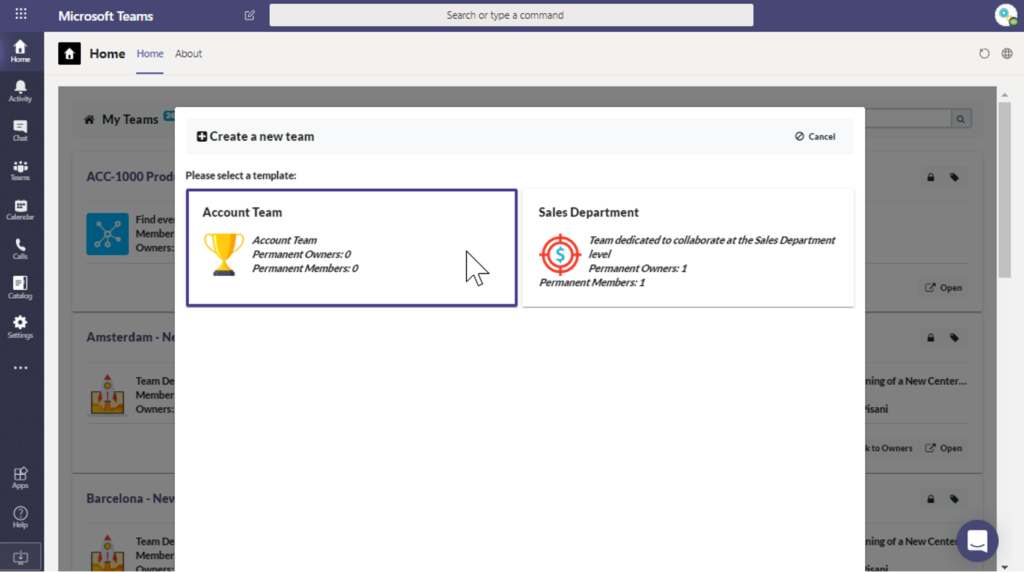
Best practice No. 3: Establish Approval workflow
Why?
You might find yourself in a situation where you want to control the team creation process to avoid chaos caused by too many teams. In this case, one of the best Microsoft Teams governance practices will be to enable Approval workflow. This means that in order to create a new team, users will need to send a request first.
At the same time, to reduce the workload of the admin who might receive dozens of requests per day, depending on the organization size, you can delegate this responsibility to other individuals in the organization. For example, to managers of different business departments.
How?
1. Through PowerApps or Power Automate and Forms
To create an approval flow with Power Automate, you can follow these instructions.
2. At the template level by nBold
With nBold, you can set up Approval workflow policies at the template level. Thus, whenever a user wants to create a new team from a pre-built template, a delegated person will automatically receive the request which they can approve or reject.
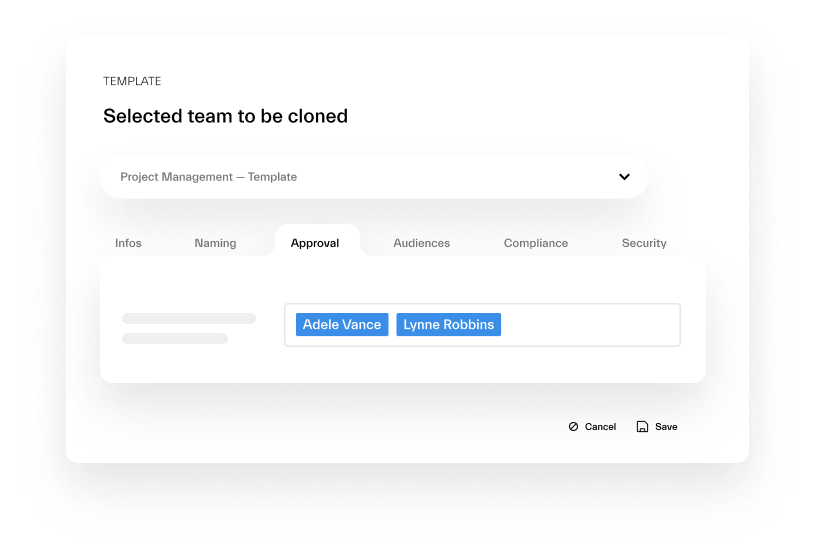
Best practice No. 4: Set up a Microsoft Teams naming convention
Why?
Setting up a naming convention is key for effective Microsoft Teams governance. It allows users to easily navigate through teams and documentation, which fosters productivity. Your workspace will be well-structured and organized which will also facilitate the work of your IT department.
It is defined by a set of attributes, such as country, city, name of the department or function.
How?
There are a few solutions for implementing a naming scheme:
1. Creating guidelines
Discuss with your IT department how users search for documentation and based on that build a set of guidelines for naming convention. Then share these guidelines with users and pray that they´ll do it.
2. Azure AD Plan 1
This Office 365 technology allows you to define a list of blocked words that cannot appear in the name of a team. It also lets you set up prefix-suffix naming policy and add attributes to your teams name. It can help your team identify which office, department, or geographic region was created for which group. But there are challenges here as every group created from the same user will get the same suffix / prefix, which doesn’t make sense in many cases.
3. Forms and Power Automate
You can build an app that will request from your users all the information necessary for team creation request, which you can then use to set a team name. In Power Automate you can implement a Form that will trigger the flow to create a new team based on the user’s data.
4. Template-based Naming Convention by nBold
With Collaboration Templates by nBold you can easily build a differentiated Naming convention (both static and dynamic) depending on your business context based on any Azure AD Attribute. Learn more.
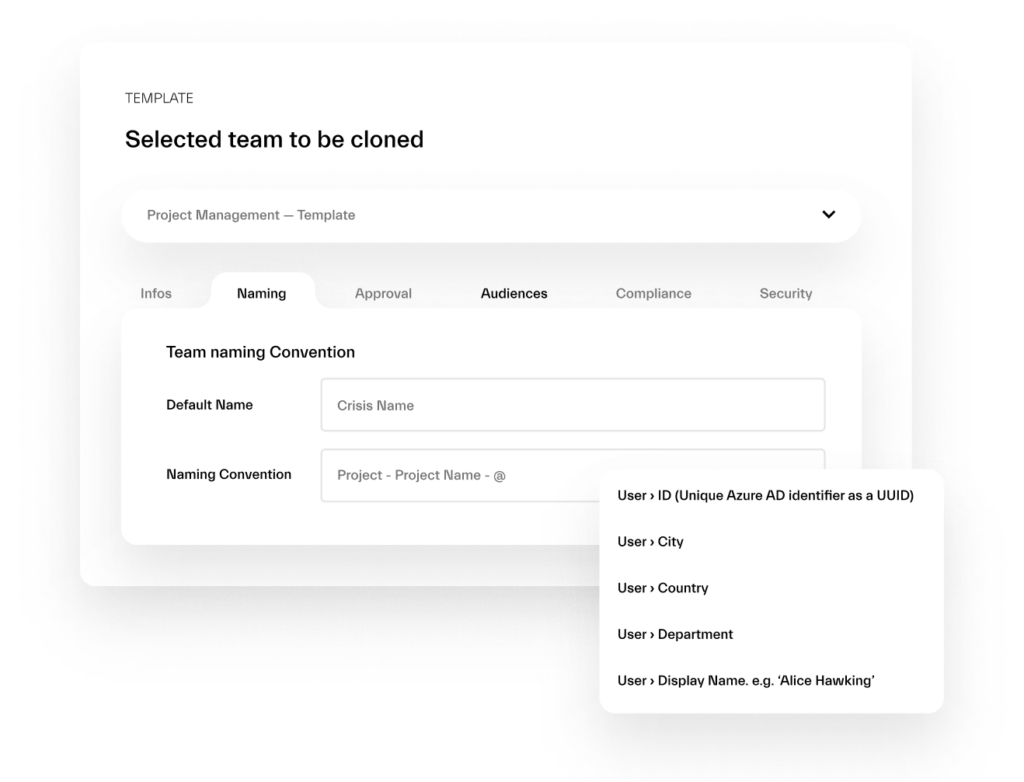
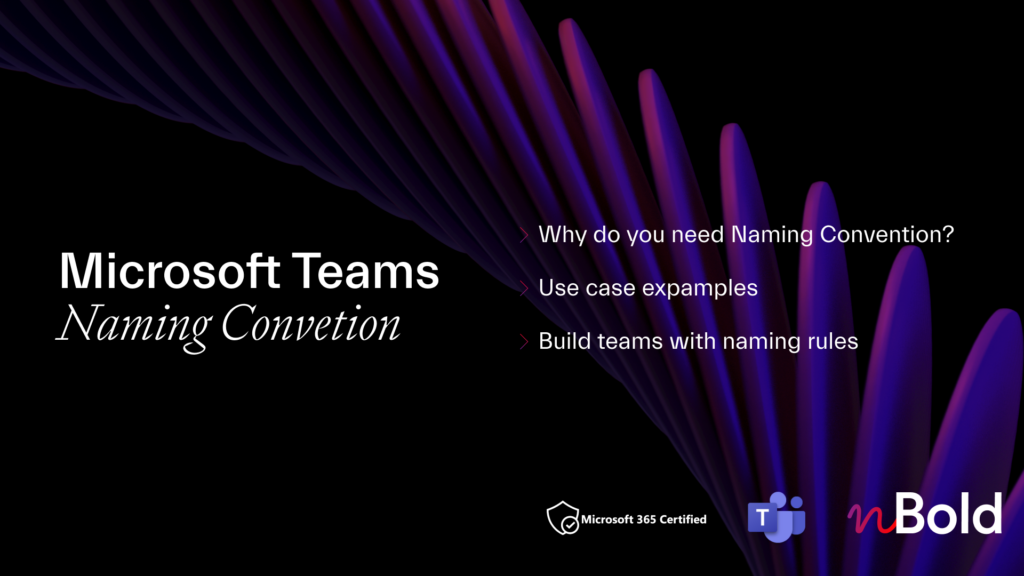
White Paper with free Teams Naming Convention examples
- Use Cases Examples
- Microsoft Teams Naming Convention Solutions
- Naming Convention at Teams Templates Level
- Fixed and Dynamic Naming Convention
Best practice No. 5: Establish the right team ownership and membership
Why?
Simply put, to better manage your teams and control what information is being shared. Team owners can remove members, add guests, change settings, and perform some administrative tasks.
How?
1. Create a set of guidelines for adding owners and members that you users will follow when creating a new team.
2. Do it manually in each team.
3. Set up Dynamic membership for teams. This means the membership of a team can be defined by one or more rules that correspond to certain user attributes in Azure AD. As a result, users are automatically added or removed to the right teams if their attributes change.

4. Define Permanent owners and members at the template level by nBold.
To elaborate a little on the last one: when you build a template, you can assign permanent owners and members that will be automatically added to new teams created from this template.
Best practice No. 6: Define teams’ settings
Why?
By customizing your teams’ settings, you can manage channels visibility, give moderator capabilities to your team members, set up guest permissions, choose who can use @mentions and set the mood of your team by enabling the use of gifs, stickers and emojis.
These features will help you ensure security and structure of each team.
How?
1. Through guidelines
You can formulate a set of guidelines for your admins and team owners that they should follow when creating a team and arranging the settings.

2. Through templates by nBold
With nBold, you can pre-configure team settings and they will stay permanent, so no additional step will be needed after creation of a new team. Al the settings will be automatically cloned.

Best practice No. 7: Manage private channels
Why?
Private channels facilitate collaboration on a specific project within a team without having to create a separate team. Only channel owners and members can get access to them.
Anyone can be added to a private channel, including guests, as long as they are already members of the team. For this reason, one of the Microsoft Teams governance best practices is to manage private channels accordingly and ensure security of confidential information.
How?
1. In Microsoft Teams admin center
In Teams policies you can determine who can create private channels.
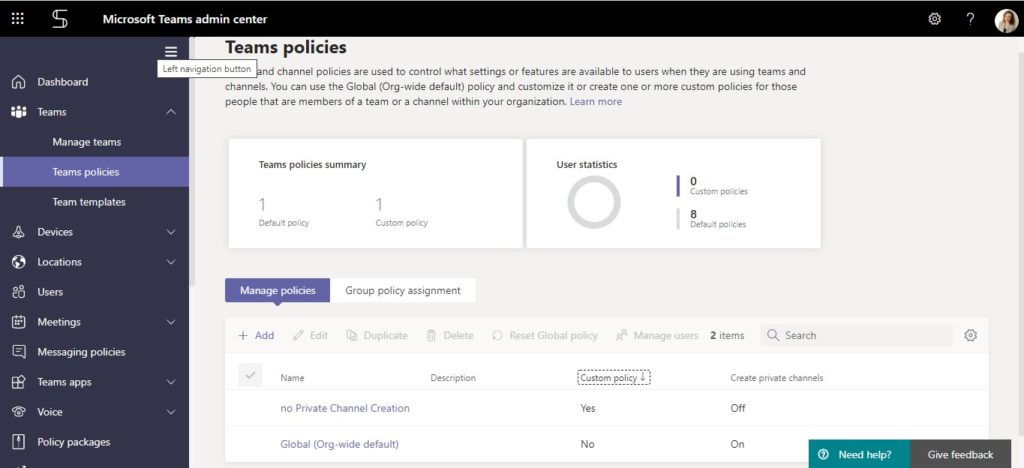
Learn more about how to master the Microsoft Teams admin center.
2. Through Templates by nBold
With nBold, you can create a template with several private channels, assign several owners by default for better control over shared materials, and pre-configure tabs.
Permanent owners become default owners in private channels.
You can disable the ability for members to create private channels in teams by disabling this setting in the original team.
Additionally, you can disable Private channels creation for everyone and configure private channels only in templates by nBold.


Best practice No. 8: Set up tagging
Why?
Tagging allows you to organize your teams at the organization level by letting users connect with a specific set of people. You can create tags to categorize users based on such attributes as their location, job position, project or skill.
Tags can be used in @mentions in channel posts or to start a chat with a specific category of users.
For example, if you work in a healthcare organization and need to tag all the doctors and nurses in a post, you can create @nurses and @doctors tags. All the team members associated with these tags will receive a notification.
How?
You can manage tags in the Microsoft Teams admin center.

There you can decide who can add custom tags: team owners and members, only team members, or disable this feature.
Additionally, you can create and assign custom tags.

Best practice No. 9: Manage third-party apps
Why?
Open access to third-party apps for end-users puts at risk the security or organization’s confidential data. Managing third-party apps, therefore, is vital in ensuring effective collaboration while keeping sensitive information safe
How?
1. By managing app setup policies.
You can highlight and pin the most important apps in teams and install apps on behalf of users.

2. By managing app permission policies.
You can control what apps are available for users in admin center:
- Allow all apps
- Allow specific apps and block all others
- Block specific apps and allow all others
- Block all apps

Learn more about Microsoft Teams security best practices.
Best practice No. 10: Enable guest access
Why?
With Microsoft Teams you can invite external guest to your teams, thus giving them access to channels, documents, apps and chats. While it´s a great feature that enables communication with clients and partners, it can cause leaks of sensitive data.
Determining whether guest access should be allowed at all or who can enable it will lower security risks.
How?
In the Microsoft Teams admin center, you can enable guest access in Teams for the whole organization. However, you can choose what features your guest users can or cannot use in Microsoft Teams.
You can manage calling, meeting, and messaging features.
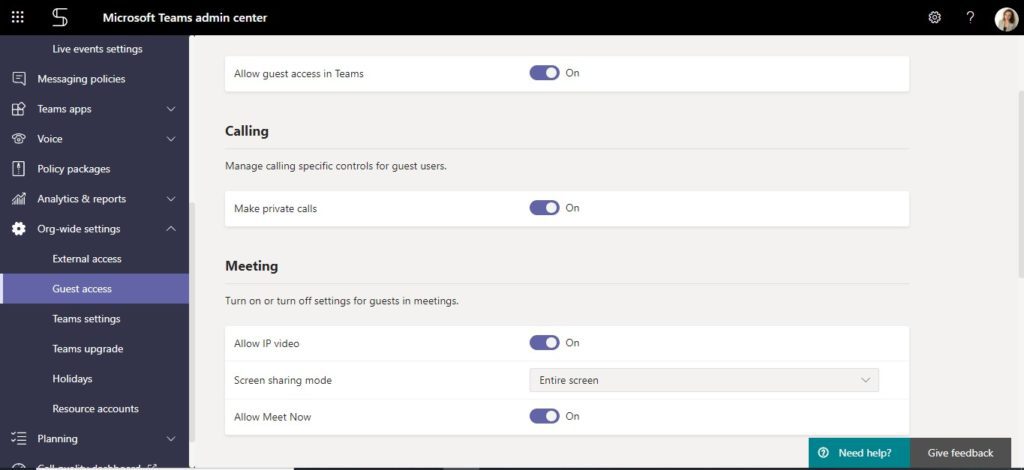
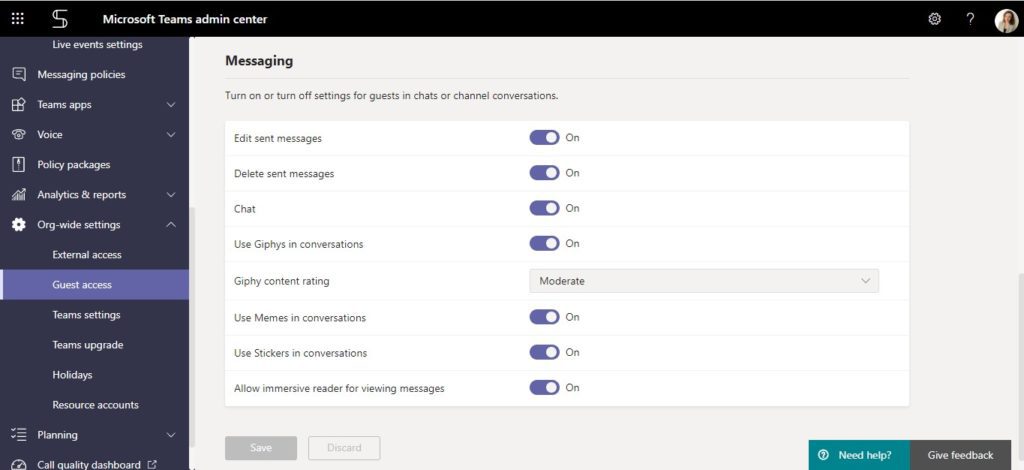
If you’d like to enable guest access only for specific teams, you can do that by using Microsoft PowerShell.
Best practice No. 11: Configure Lifecycle management policies
Why?
Lifecycle management policies allow you to better structure and organize your teams, as well as save storage space from unnecessary data. Additionally, some teams that are no longer in use can still contain some sensitive information that, if not managed properly, can be leaked.
How?
You can simply archive or delete the teams you no longer need. However, if your organization has too many teams, it’s better to automate this process.
You can establish Lifecycle policies with Azure AD Premium license. For example, you can set to archive all office 365 groups with no activity in the past 90 days or set a group expiration.

Best practice No. 12: Create custom calling policies
Why?
You can determine which calling and call forwarding features are available for your end-users.
You can configure the following settings: make private calls, forward calls, have simultaneous calls to people both within the organization and to external members, enable voicemail, route inbound calls to group calls, delegate inbound and outbound calls, prevent toll bypass and send calls through the PSTN, enable Busy options, allow web PSTN calling and allow music on call.
How?
In the Microsoft Teams admin center go to Voice and select Calling Policies and click on Add.
Then choose all the features that you want to use for your calling policy.
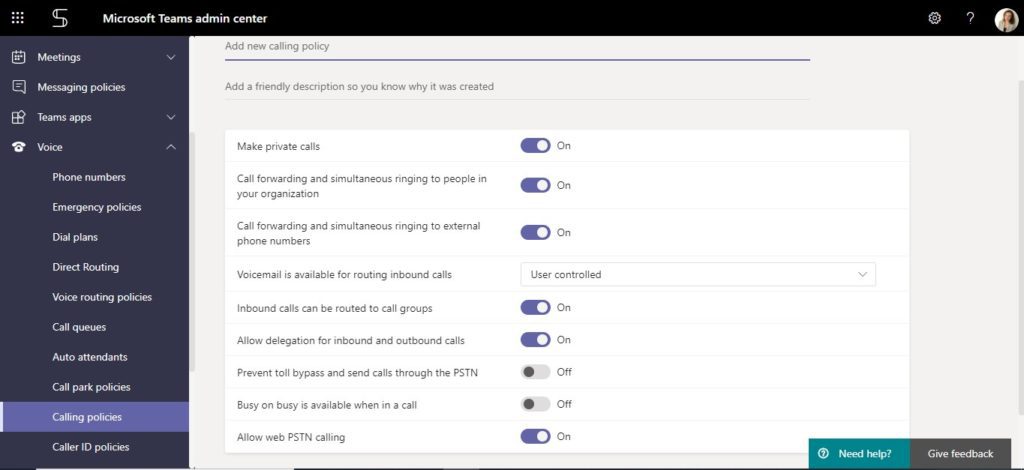
Best practice No. 13: Manage meeting settings and policies
Why?
Microsoft Teams offers a lot of interesting meeting features for its users so make sure to take advantage of them by customizing your meeting setting and policies.
For example, you can make available Meet now feature, allow scheduling of private meetings, cloud recording, transcription, and content sharing, let anonymous users join a meeting, customize meeting invitations and others.
Find out more about meeting policies and meeting settings.
How?
In the Microsoft Teams admin center go to Meetings, then click on Meetings to control what features are available to users. Click on add and choose the right features in General, Audio & video, Content sharing, Participants & guests.

Then you can go to Meeting settings to control whether anonymous users can join a meeting, to customize email invitations, or to handle real-time media traffic.

Best practice No. 14: Define other admin level Teams settings
Why?
You can set up your teams for such features as email integration, cloud storage options and device set up.
Email integration will allow users to send an email to a Teams channel and have its content displayed for everyone within the team. This feature saves time and improves teamwork by providing a single collaborative platform.
Additionally, you can allow or restrict files sharing to better organize your documentation and determine which devices can get access to Teams meetings to ensure security.
How?
In the Microsoft Teams admin center choose Org-wide settings and go to Teams settings.
Then select all the features that you want to set up.


Best practice No. 15: Define Teams policies on the group level
Why?
Within each organization there are distinct kinds of users with specific needs. You can tailor Teams policies according to those needs making it easier to manage your organization. You can assign policies directly to specific individuals, or to a group that these users are members of.
How?
In Microsoft Teams admin center go to Teams, Click on Teams policies, then choose Group policy assignment and create your new group policy.
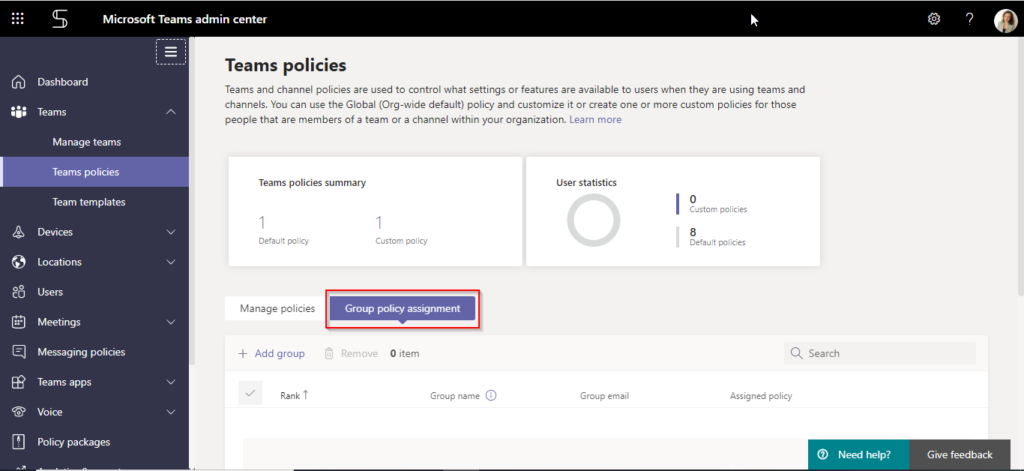
These Microsoft Teams governance best practices will ensure a great experience for your end-users around Microsoft Teams in your organization.
Talk to our team and find out how to establish strong Microsoft Teams governance without killing adoption.